The Pattern of Trade in India and China Research Paper 2022
VerifiedAdded on 2022/09/12
|15
|4394
|32
AI Summary
Contribute Materials
Your contribution can guide someone’s learning journey. Share your
documents today.
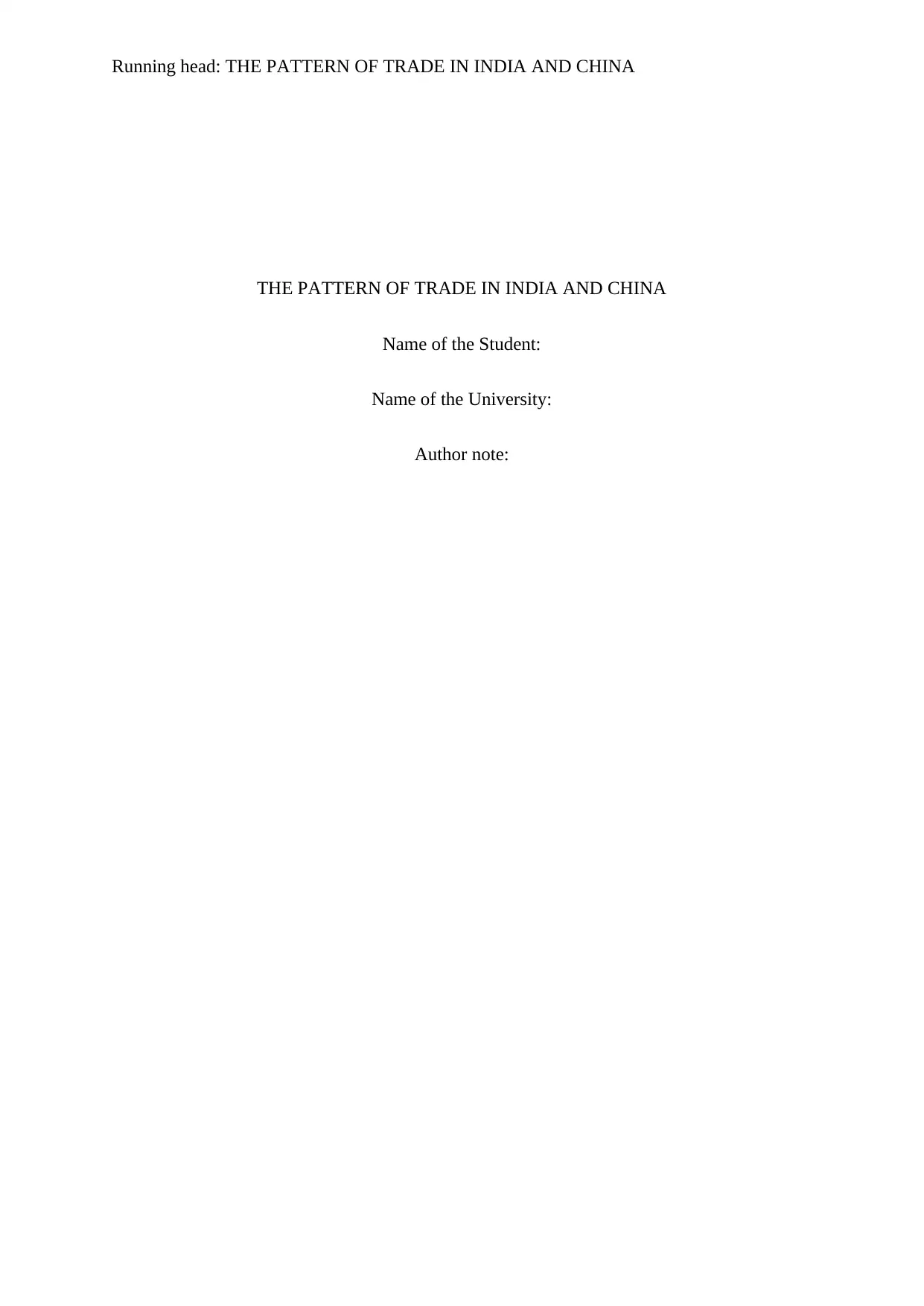
Running head: THE PATTERN OF TRADE IN INDIA AND CHINA
THE PATTERN OF TRADE IN INDIA AND CHINA
Name of the Student:
Name of the University:
Author note:
THE PATTERN OF TRADE IN INDIA AND CHINA
Name of the Student:
Name of the University:
Author note:
Secure Best Marks with AI Grader
Need help grading? Try our AI Grader for instant feedback on your assignments.
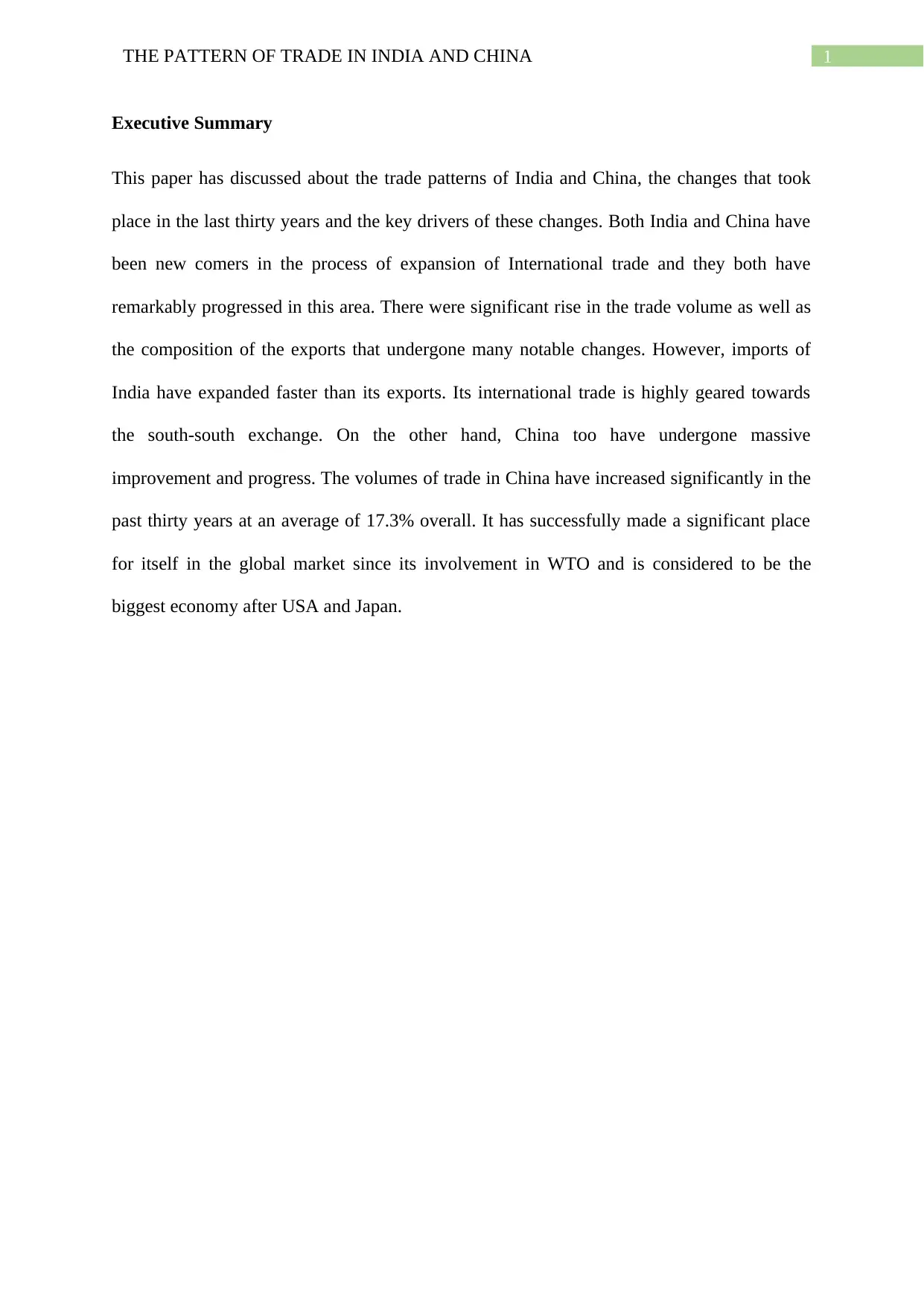
1THE PATTERN OF TRADE IN INDIA AND CHINA
Executive Summary
This paper has discussed about the trade patterns of India and China, the changes that took
place in the last thirty years and the key drivers of these changes. Both India and China have
been new comers in the process of expansion of International trade and they both have
remarkably progressed in this area. There were significant rise in the trade volume as well as
the composition of the exports that undergone many notable changes. However, imports of
India have expanded faster than its exports. Its international trade is highly geared towards
the south-south exchange. On the other hand, China too have undergone massive
improvement and progress. The volumes of trade in China have increased significantly in the
past thirty years at an average of 17.3% overall. It has successfully made a significant place
for itself in the global market since its involvement in WTO and is considered to be the
biggest economy after USA and Japan.
Executive Summary
This paper has discussed about the trade patterns of India and China, the changes that took
place in the last thirty years and the key drivers of these changes. Both India and China have
been new comers in the process of expansion of International trade and they both have
remarkably progressed in this area. There were significant rise in the trade volume as well as
the composition of the exports that undergone many notable changes. However, imports of
India have expanded faster than its exports. Its international trade is highly geared towards
the south-south exchange. On the other hand, China too have undergone massive
improvement and progress. The volumes of trade in China have increased significantly in the
past thirty years at an average of 17.3% overall. It has successfully made a significant place
for itself in the global market since its involvement in WTO and is considered to be the
biggest economy after USA and Japan.
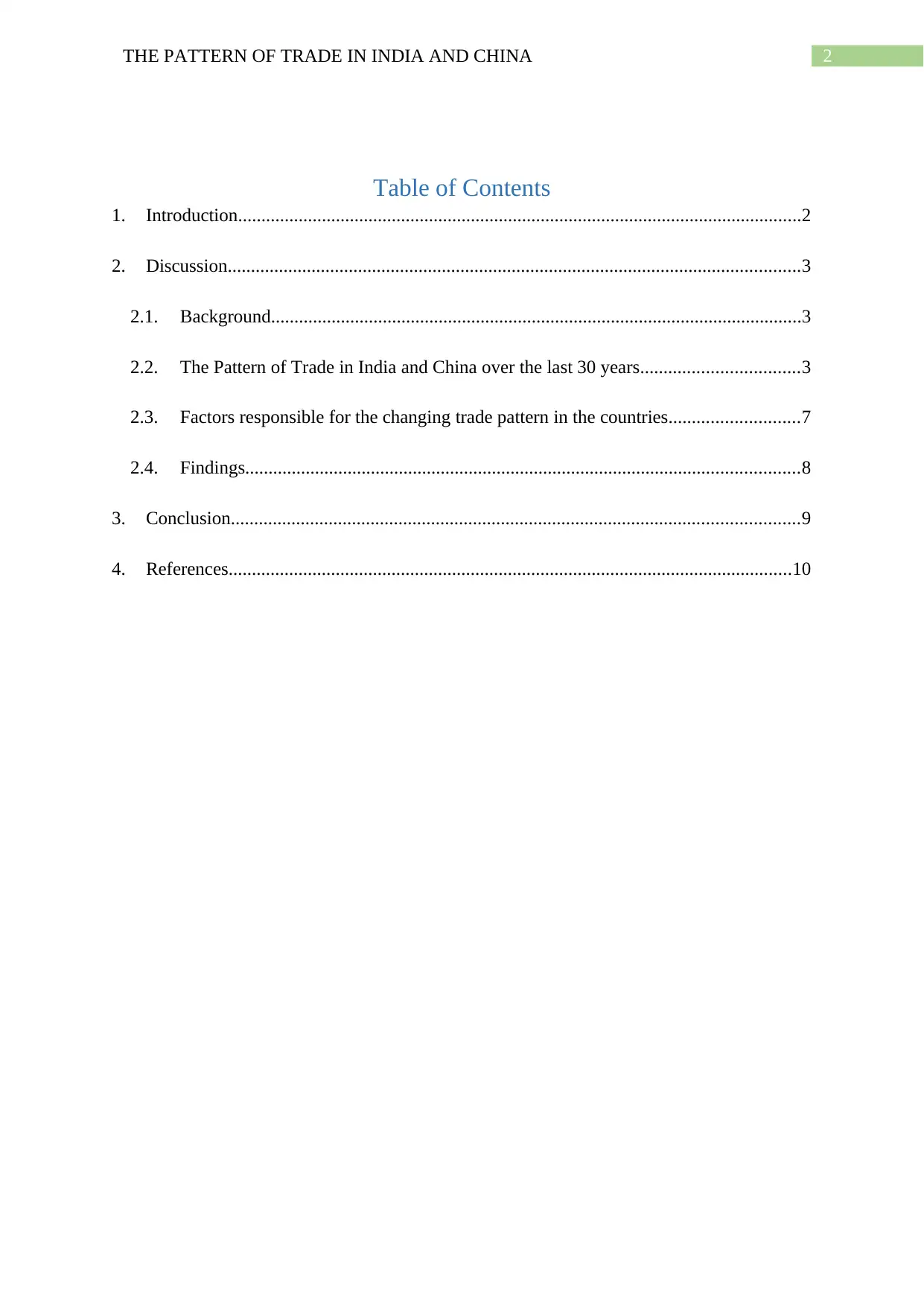
2THE PATTERN OF TRADE IN INDIA AND CHINA
Table of Contents
1. Introduction.........................................................................................................................2
2. Discussion...........................................................................................................................3
2.1. Background..................................................................................................................3
2.2. The Pattern of Trade in India and China over the last 30 years..................................3
2.3. Factors responsible for the changing trade pattern in the countries............................7
2.4. Findings.......................................................................................................................8
3. Conclusion..........................................................................................................................9
4. References.........................................................................................................................10
Table of Contents
1. Introduction.........................................................................................................................2
2. Discussion...........................................................................................................................3
2.1. Background..................................................................................................................3
2.2. The Pattern of Trade in India and China over the last 30 years..................................3
2.3. Factors responsible for the changing trade pattern in the countries............................7
2.4. Findings.......................................................................................................................8
3. Conclusion..........................................................................................................................9
4. References.........................................................................................................................10
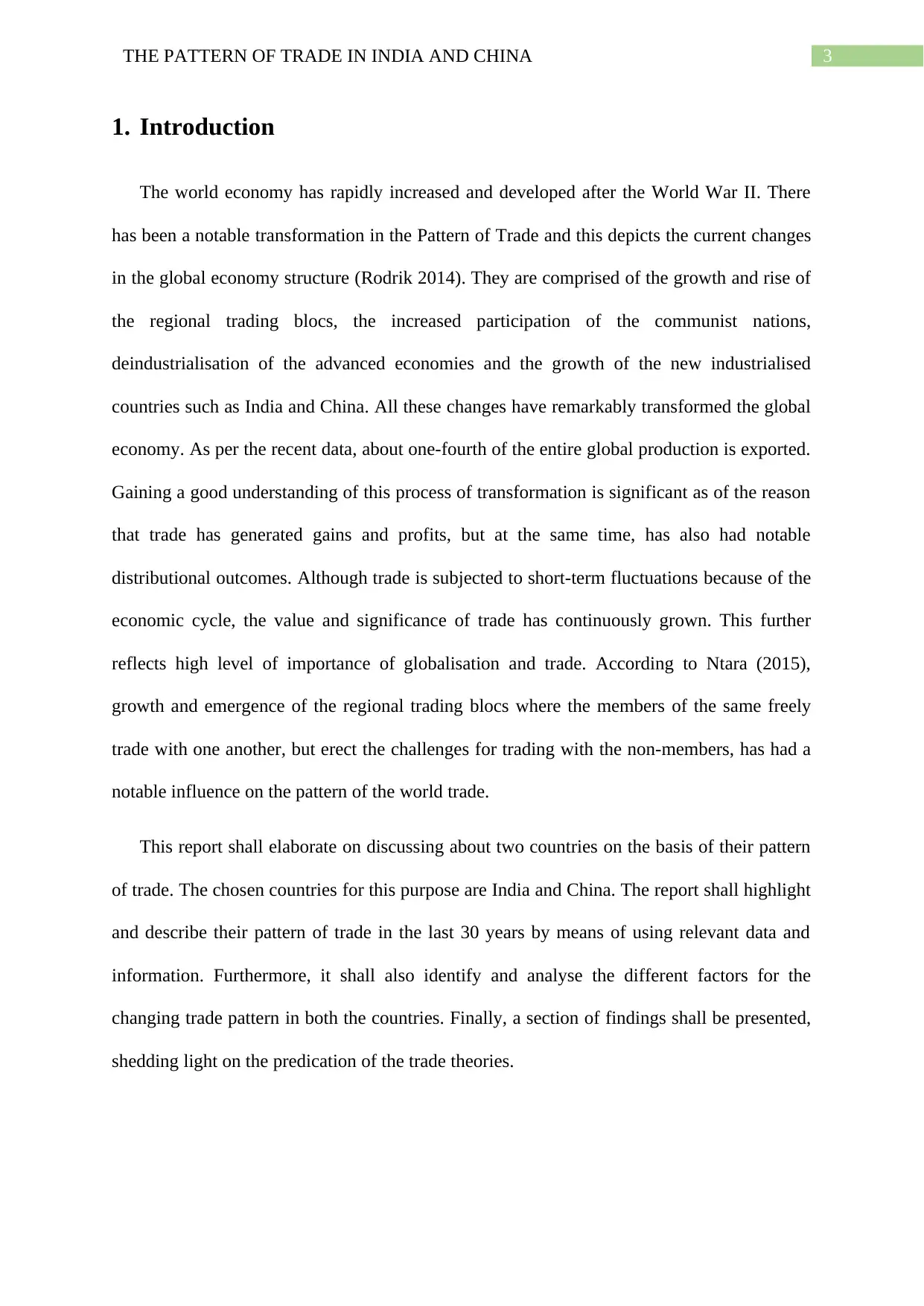
3THE PATTERN OF TRADE IN INDIA AND CHINA
1. Introduction
The world economy has rapidly increased and developed after the World War II. There
has been a notable transformation in the Pattern of Trade and this depicts the current changes
in the global economy structure (Rodrik 2014). They are comprised of the growth and rise of
the regional trading blocs, the increased participation of the communist nations,
deindustrialisation of the advanced economies and the growth of the new industrialised
countries such as India and China. All these changes have remarkably transformed the global
economy. As per the recent data, about one-fourth of the entire global production is exported.
Gaining a good understanding of this process of transformation is significant as of the reason
that trade has generated gains and profits, but at the same time, has also had notable
distributional outcomes. Although trade is subjected to short-term fluctuations because of the
economic cycle, the value and significance of trade has continuously grown. This further
reflects high level of importance of globalisation and trade. According to Ntara (2015),
growth and emergence of the regional trading blocs where the members of the same freely
trade with one another, but erect the challenges for trading with the non-members, has had a
notable influence on the pattern of the world trade.
This report shall elaborate on discussing about two countries on the basis of their pattern
of trade. The chosen countries for this purpose are India and China. The report shall highlight
and describe their pattern of trade in the last 30 years by means of using relevant data and
information. Furthermore, it shall also identify and analyse the different factors for the
changing trade pattern in both the countries. Finally, a section of findings shall be presented,
shedding light on the predication of the trade theories.
1. Introduction
The world economy has rapidly increased and developed after the World War II. There
has been a notable transformation in the Pattern of Trade and this depicts the current changes
in the global economy structure (Rodrik 2014). They are comprised of the growth and rise of
the regional trading blocs, the increased participation of the communist nations,
deindustrialisation of the advanced economies and the growth of the new industrialised
countries such as India and China. All these changes have remarkably transformed the global
economy. As per the recent data, about one-fourth of the entire global production is exported.
Gaining a good understanding of this process of transformation is significant as of the reason
that trade has generated gains and profits, but at the same time, has also had notable
distributional outcomes. Although trade is subjected to short-term fluctuations because of the
economic cycle, the value and significance of trade has continuously grown. This further
reflects high level of importance of globalisation and trade. According to Ntara (2015),
growth and emergence of the regional trading blocs where the members of the same freely
trade with one another, but erect the challenges for trading with the non-members, has had a
notable influence on the pattern of the world trade.
This report shall elaborate on discussing about two countries on the basis of their pattern
of trade. The chosen countries for this purpose are India and China. The report shall highlight
and describe their pattern of trade in the last 30 years by means of using relevant data and
information. Furthermore, it shall also identify and analyse the different factors for the
changing trade pattern in both the countries. Finally, a section of findings shall be presented,
shedding light on the predication of the trade theories.
Secure Best Marks with AI Grader
Need help grading? Try our AI Grader for instant feedback on your assignments.
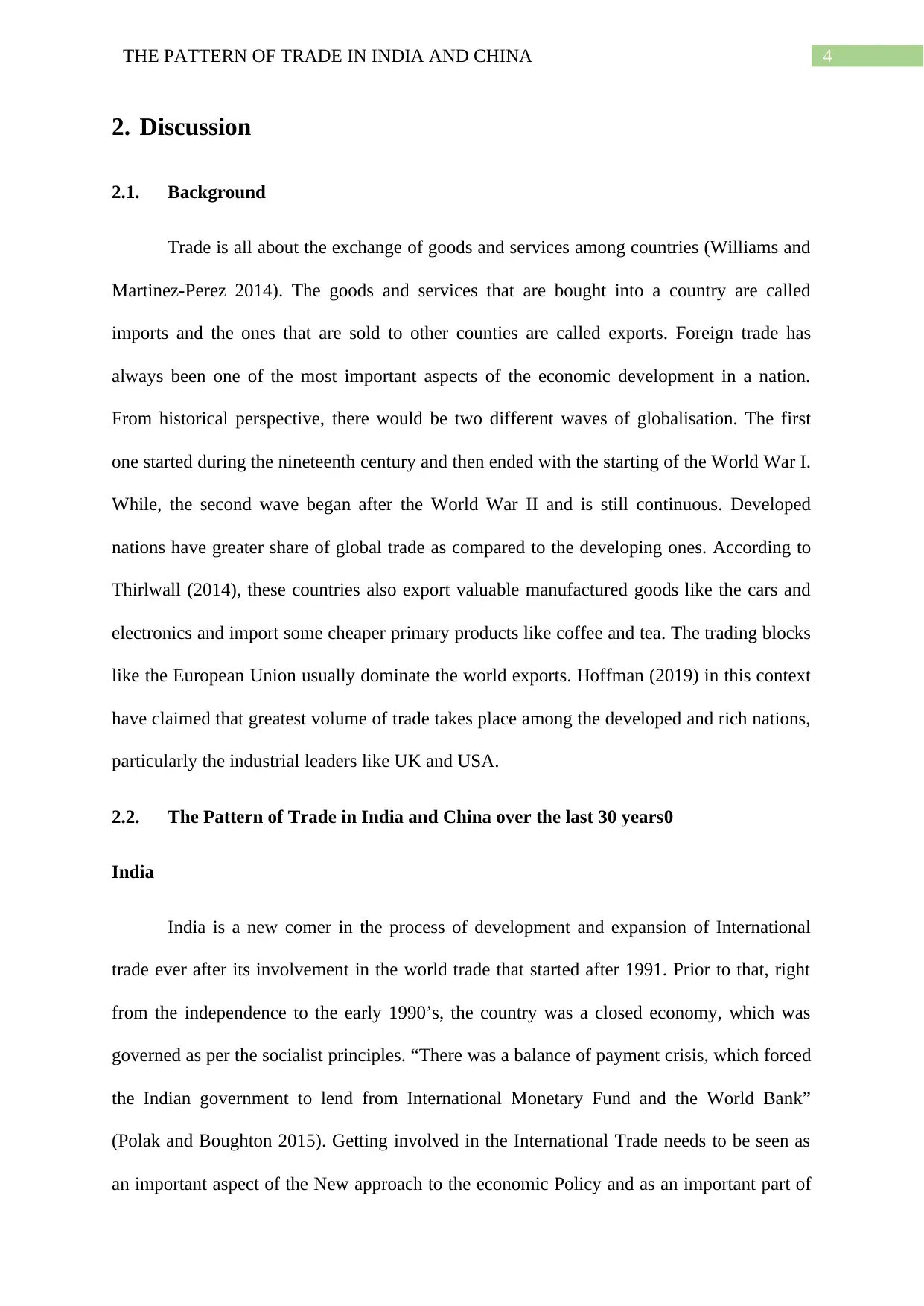
4THE PATTERN OF TRADE IN INDIA AND CHINA
2. Discussion
2.1. Background
Trade is all about the exchange of goods and services among countries (Williams and
Martinez-Perez 2014). The goods and services that are bought into a country are called
imports and the ones that are sold to other counties are called exports. Foreign trade has
always been one of the most important aspects of the economic development in a nation.
From historical perspective, there would be two different waves of globalisation. The first
one started during the nineteenth century and then ended with the starting of the World War I.
While, the second wave began after the World War II and is still continuous. Developed
nations have greater share of global trade as compared to the developing ones. According to
Thirlwall (2014), these countries also export valuable manufactured goods like the cars and
electronics and import some cheaper primary products like coffee and tea. The trading blocks
like the European Union usually dominate the world exports. Hoffman (2019) in this context
have claimed that greatest volume of trade takes place among the developed and rich nations,
particularly the industrial leaders like UK and USA.
2.2. The Pattern of Trade in India and China over the last 30 years0
India
India is a new comer in the process of development and expansion of International
trade ever after its involvement in the world trade that started after 1991. Prior to that, right
from the independence to the early 1990’s, the country was a closed economy, which was
governed as per the socialist principles. “There was a balance of payment crisis, which forced
the Indian government to lend from International Monetary Fund and the World Bank”
(Polak and Boughton 2015). Getting involved in the International Trade needs to be seen as
an important aspect of the New approach to the economic Policy and as an important part of
2. Discussion
2.1. Background
Trade is all about the exchange of goods and services among countries (Williams and
Martinez-Perez 2014). The goods and services that are bought into a country are called
imports and the ones that are sold to other counties are called exports. Foreign trade has
always been one of the most important aspects of the economic development in a nation.
From historical perspective, there would be two different waves of globalisation. The first
one started during the nineteenth century and then ended with the starting of the World War I.
While, the second wave began after the World War II and is still continuous. Developed
nations have greater share of global trade as compared to the developing ones. According to
Thirlwall (2014), these countries also export valuable manufactured goods like the cars and
electronics and import some cheaper primary products like coffee and tea. The trading blocks
like the European Union usually dominate the world exports. Hoffman (2019) in this context
have claimed that greatest volume of trade takes place among the developed and rich nations,
particularly the industrial leaders like UK and USA.
2.2. The Pattern of Trade in India and China over the last 30 years0
India
India is a new comer in the process of development and expansion of International
trade ever after its involvement in the world trade that started after 1991. Prior to that, right
from the independence to the early 1990’s, the country was a closed economy, which was
governed as per the socialist principles. “There was a balance of payment crisis, which forced
the Indian government to lend from International Monetary Fund and the World Bank”
(Polak and Boughton 2015). Getting involved in the International Trade needs to be seen as
an important aspect of the New approach to the economic Policy and as an important part of
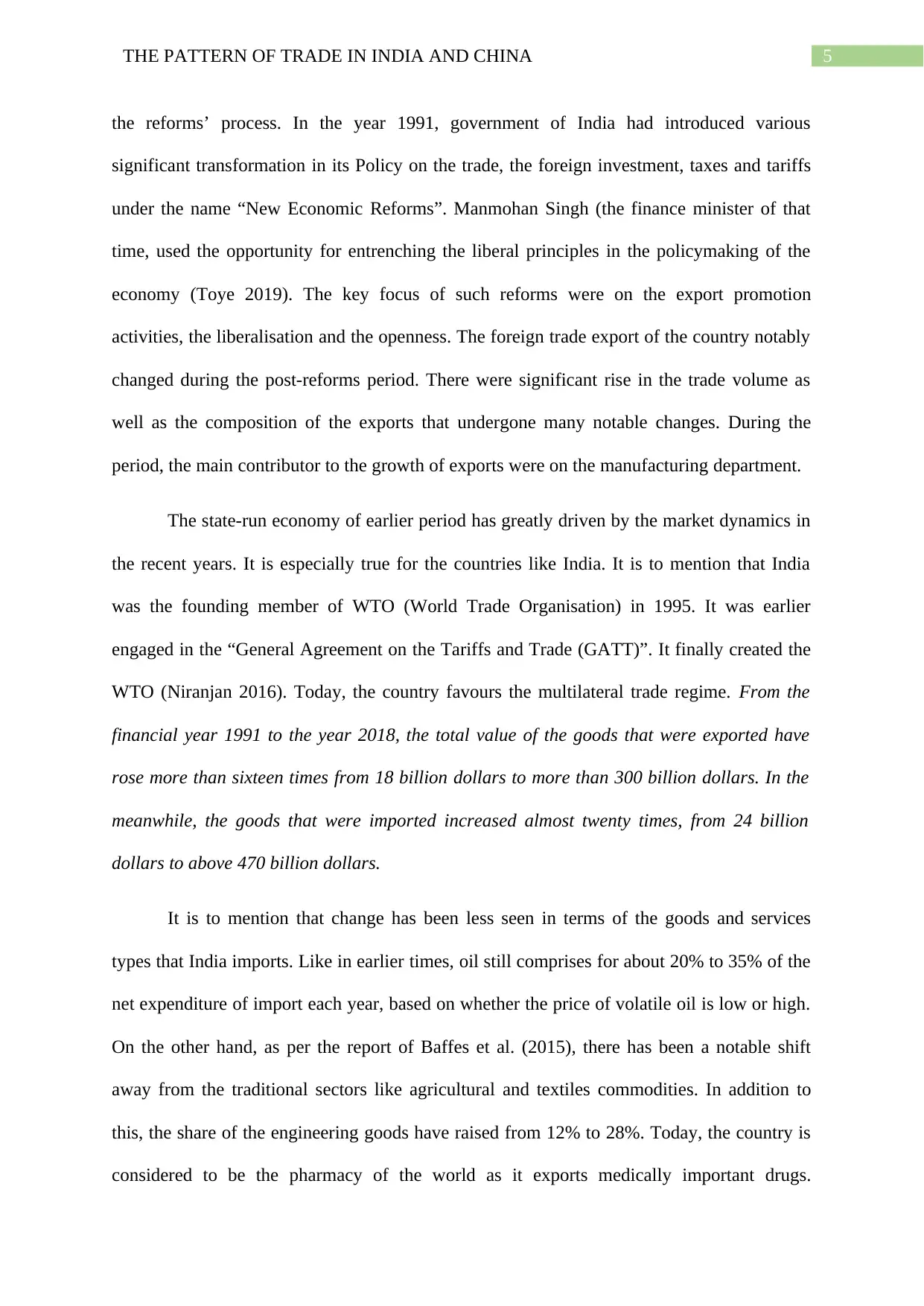
5THE PATTERN OF TRADE IN INDIA AND CHINA
the reforms’ process. In the year 1991, government of India had introduced various
significant transformation in its Policy on the trade, the foreign investment, taxes and tariffs
under the name “New Economic Reforms”. Manmohan Singh (the finance minister of that
time, used the opportunity for entrenching the liberal principles in the policymaking of the
economy (Toye 2019). The key focus of such reforms were on the export promotion
activities, the liberalisation and the openness. The foreign trade export of the country notably
changed during the post-reforms period. There were significant rise in the trade volume as
well as the composition of the exports that undergone many notable changes. During the
period, the main contributor to the growth of exports were on the manufacturing department.
The state-run economy of earlier period has greatly driven by the market dynamics in
the recent years. It is especially true for the countries like India. It is to mention that India
was the founding member of WTO (World Trade Organisation) in 1995. It was earlier
engaged in the “General Agreement on the Tariffs and Trade (GATT)”. It finally created the
WTO (Niranjan 2016). Today, the country favours the multilateral trade regime. From the
financial year 1991 to the year 2018, the total value of the goods that were exported have
rose more than sixteen times from 18 billion dollars to more than 300 billion dollars. In the
meanwhile, the goods that were imported increased almost twenty times, from 24 billion
dollars to above 470 billion dollars.
It is to mention that change has been less seen in terms of the goods and services
types that India imports. Like in earlier times, oil still comprises for about 20% to 35% of the
net expenditure of import each year, based on whether the price of volatile oil is low or high.
On the other hand, as per the report of Baffes et al. (2015), there has been a notable shift
away from the traditional sectors like agricultural and textiles commodities. In addition to
this, the share of the engineering goods have raised from 12% to 28%. Today, the country is
considered to be the pharmacy of the world as it exports medically important drugs.
the reforms’ process. In the year 1991, government of India had introduced various
significant transformation in its Policy on the trade, the foreign investment, taxes and tariffs
under the name “New Economic Reforms”. Manmohan Singh (the finance minister of that
time, used the opportunity for entrenching the liberal principles in the policymaking of the
economy (Toye 2019). The key focus of such reforms were on the export promotion
activities, the liberalisation and the openness. The foreign trade export of the country notably
changed during the post-reforms period. There were significant rise in the trade volume as
well as the composition of the exports that undergone many notable changes. During the
period, the main contributor to the growth of exports were on the manufacturing department.
The state-run economy of earlier period has greatly driven by the market dynamics in
the recent years. It is especially true for the countries like India. It is to mention that India
was the founding member of WTO (World Trade Organisation) in 1995. It was earlier
engaged in the “General Agreement on the Tariffs and Trade (GATT)”. It finally created the
WTO (Niranjan 2016). Today, the country favours the multilateral trade regime. From the
financial year 1991 to the year 2018, the total value of the goods that were exported have
rose more than sixteen times from 18 billion dollars to more than 300 billion dollars. In the
meanwhile, the goods that were imported increased almost twenty times, from 24 billion
dollars to above 470 billion dollars.
It is to mention that change has been less seen in terms of the goods and services
types that India imports. Like in earlier times, oil still comprises for about 20% to 35% of the
net expenditure of import each year, based on whether the price of volatile oil is low or high.
On the other hand, as per the report of Baffes et al. (2015), there has been a notable shift
away from the traditional sectors like agricultural and textiles commodities. In addition to
this, the share of the engineering goods have raised from 12% to 28%. Today, the country is
considered to be the pharmacy of the world as it exports medically important drugs.
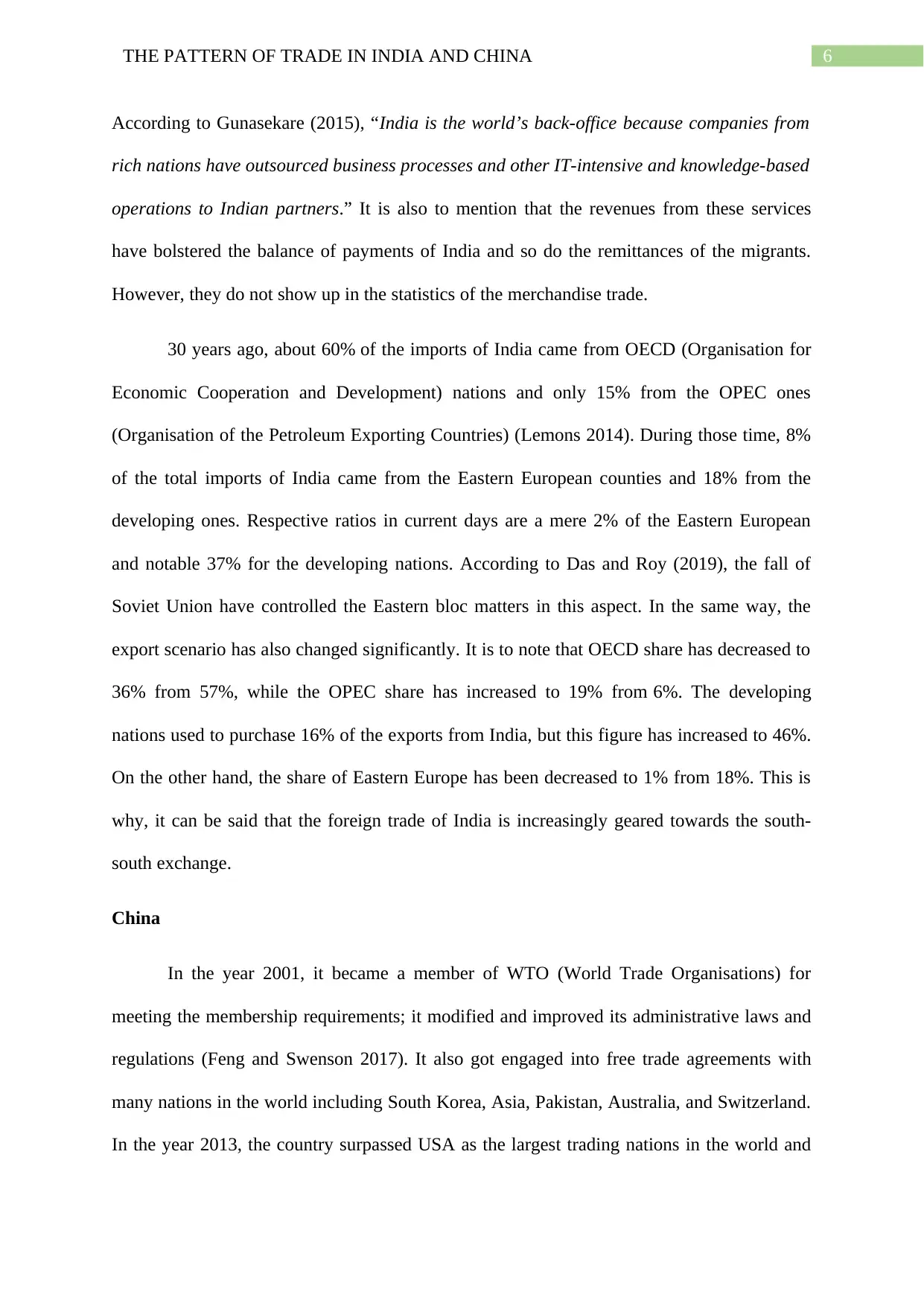
6THE PATTERN OF TRADE IN INDIA AND CHINA
According to Gunasekare (2015), “India is the world’s back-office because companies from
rich nations have outsourced business processes and other IT-intensive and knowledge-based
operations to Indian partners.” It is also to mention that the revenues from these services
have bolstered the balance of payments of India and so do the remittances of the migrants.
However, they do not show up in the statistics of the merchandise trade.
30 years ago, about 60% of the imports of India came from OECD (Organisation for
Economic Cooperation and Development) nations and only 15% from the OPEC ones
(Organisation of the Petroleum Exporting Countries) (Lemons 2014). During those time, 8%
of the total imports of India came from the Eastern European counties and 18% from the
developing ones. Respective ratios in current days are a mere 2% of the Eastern European
and notable 37% for the developing nations. According to Das and Roy (2019), the fall of
Soviet Union have controlled the Eastern bloc matters in this aspect. In the same way, the
export scenario has also changed significantly. It is to note that OECD share has decreased to
36% from 57%, while the OPEC share has increased to 19% from 6%. The developing
nations used to purchase 16% of the exports from India, but this figure has increased to 46%.
On the other hand, the share of Eastern Europe has been decreased to 1% from 18%. This is
why, it can be said that the foreign trade of India is increasingly geared towards the south-
south exchange.
China
In the year 2001, it became a member of WTO (World Trade Organisations) for
meeting the membership requirements; it modified and improved its administrative laws and
regulations (Feng and Swenson 2017). It also got engaged into free trade agreements with
many nations in the world including South Korea, Asia, Pakistan, Australia, and Switzerland.
In the year 2013, the country surpassed USA as the largest trading nations in the world and
According to Gunasekare (2015), “India is the world’s back-office because companies from
rich nations have outsourced business processes and other IT-intensive and knowledge-based
operations to Indian partners.” It is also to mention that the revenues from these services
have bolstered the balance of payments of India and so do the remittances of the migrants.
However, they do not show up in the statistics of the merchandise trade.
30 years ago, about 60% of the imports of India came from OECD (Organisation for
Economic Cooperation and Development) nations and only 15% from the OPEC ones
(Organisation of the Petroleum Exporting Countries) (Lemons 2014). During those time, 8%
of the total imports of India came from the Eastern European counties and 18% from the
developing ones. Respective ratios in current days are a mere 2% of the Eastern European
and notable 37% for the developing nations. According to Das and Roy (2019), the fall of
Soviet Union have controlled the Eastern bloc matters in this aspect. In the same way, the
export scenario has also changed significantly. It is to note that OECD share has decreased to
36% from 57%, while the OPEC share has increased to 19% from 6%. The developing
nations used to purchase 16% of the exports from India, but this figure has increased to 46%.
On the other hand, the share of Eastern Europe has been decreased to 1% from 18%. This is
why, it can be said that the foreign trade of India is increasingly geared towards the south-
south exchange.
China
In the year 2001, it became a member of WTO (World Trade Organisations) for
meeting the membership requirements; it modified and improved its administrative laws and
regulations (Feng and Swenson 2017). It also got engaged into free trade agreements with
many nations in the world including South Korea, Asia, Pakistan, Australia, and Switzerland.
In the year 2013, the country surpassed USA as the largest trading nations in the world and
Paraphrase This Document
Need a fresh take? Get an instant paraphrase of this document with our AI Paraphraser
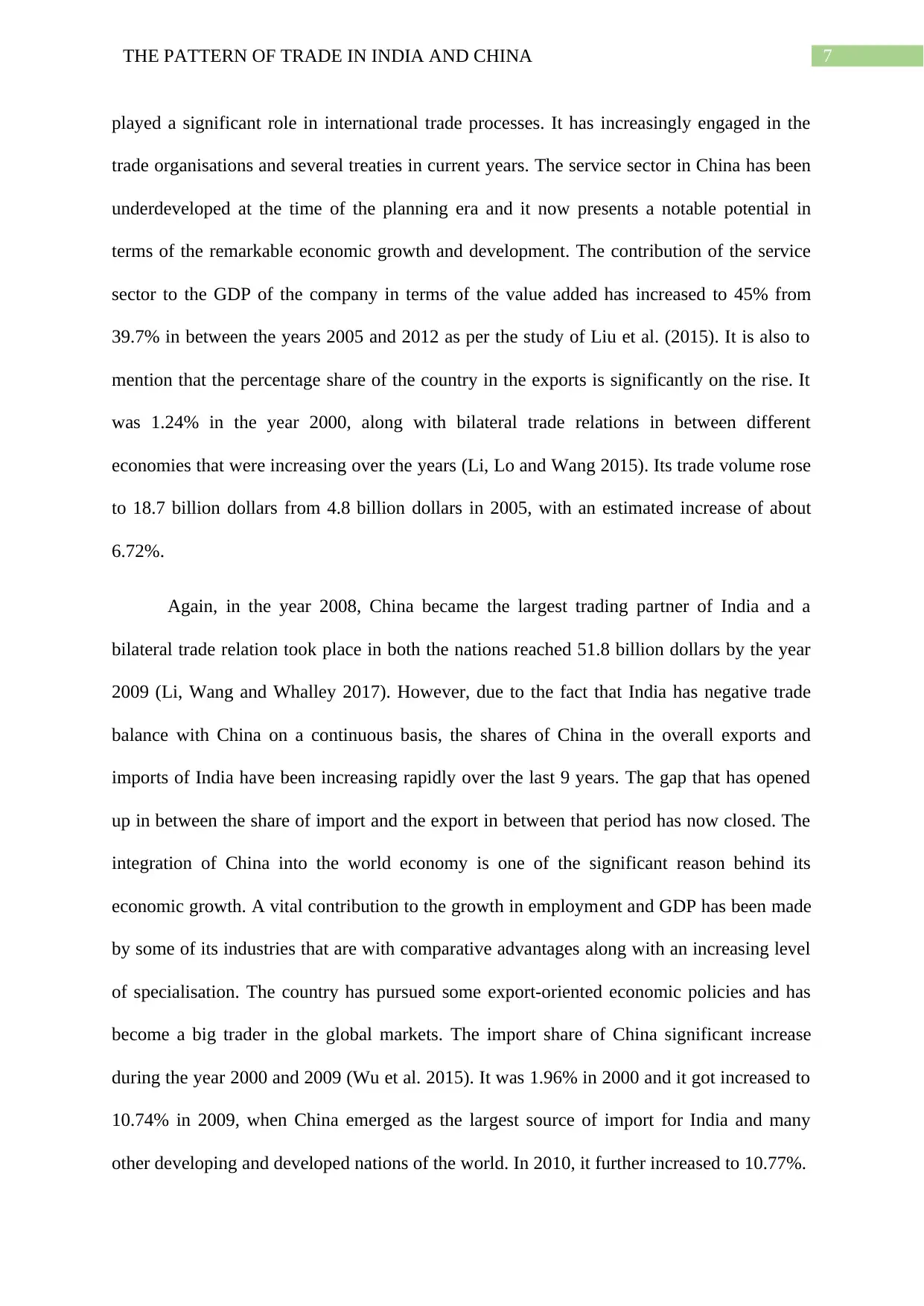
7THE PATTERN OF TRADE IN INDIA AND CHINA
played a significant role in international trade processes. It has increasingly engaged in the
trade organisations and several treaties in current years. The service sector in China has been
underdeveloped at the time of the planning era and it now presents a notable potential in
terms of the remarkable economic growth and development. The contribution of the service
sector to the GDP of the company in terms of the value added has increased to 45% from
39.7% in between the years 2005 and 2012 as per the study of Liu et al. (2015). It is also to
mention that the percentage share of the country in the exports is significantly on the rise. It
was 1.24% in the year 2000, along with bilateral trade relations in between different
economies that were increasing over the years (Li, Lo and Wang 2015). Its trade volume rose
to 18.7 billion dollars from 4.8 billion dollars in 2005, with an estimated increase of about
6.72%.
Again, in the year 2008, China became the largest trading partner of India and a
bilateral trade relation took place in both the nations reached 51.8 billion dollars by the year
2009 (Li, Wang and Whalley 2017). However, due to the fact that India has negative trade
balance with China on a continuous basis, the shares of China in the overall exports and
imports of India have been increasing rapidly over the last 9 years. The gap that has opened
up in between the share of import and the export in between that period has now closed. The
integration of China into the world economy is one of the significant reason behind its
economic growth. A vital contribution to the growth in employment and GDP has been made
by some of its industries that are with comparative advantages along with an increasing level
of specialisation. The country has pursued some export-oriented economic policies and has
become a big trader in the global markets. The import share of China significant increase
during the year 2000 and 2009 (Wu et al. 2015). It was 1.96% in 2000 and it got increased to
10.74% in 2009, when China emerged as the largest source of import for India and many
other developing and developed nations of the world. In 2010, it further increased to 10.77%.
played a significant role in international trade processes. It has increasingly engaged in the
trade organisations and several treaties in current years. The service sector in China has been
underdeveloped at the time of the planning era and it now presents a notable potential in
terms of the remarkable economic growth and development. The contribution of the service
sector to the GDP of the company in terms of the value added has increased to 45% from
39.7% in between the years 2005 and 2012 as per the study of Liu et al. (2015). It is also to
mention that the percentage share of the country in the exports is significantly on the rise. It
was 1.24% in the year 2000, along with bilateral trade relations in between different
economies that were increasing over the years (Li, Lo and Wang 2015). Its trade volume rose
to 18.7 billion dollars from 4.8 billion dollars in 2005, with an estimated increase of about
6.72%.
Again, in the year 2008, China became the largest trading partner of India and a
bilateral trade relation took place in both the nations reached 51.8 billion dollars by the year
2009 (Li, Wang and Whalley 2017). However, due to the fact that India has negative trade
balance with China on a continuous basis, the shares of China in the overall exports and
imports of India have been increasing rapidly over the last 9 years. The gap that has opened
up in between the share of import and the export in between that period has now closed. The
integration of China into the world economy is one of the significant reason behind its
economic growth. A vital contribution to the growth in employment and GDP has been made
by some of its industries that are with comparative advantages along with an increasing level
of specialisation. The country has pursued some export-oriented economic policies and has
become a big trader in the global markets. The import share of China significant increase
during the year 2000 and 2009 (Wu et al. 2015). It was 1.96% in 2000 and it got increased to
10.74% in 2009, when China emerged as the largest source of import for India and many
other developing and developed nations of the world. In 2010, it further increased to 10.77%.
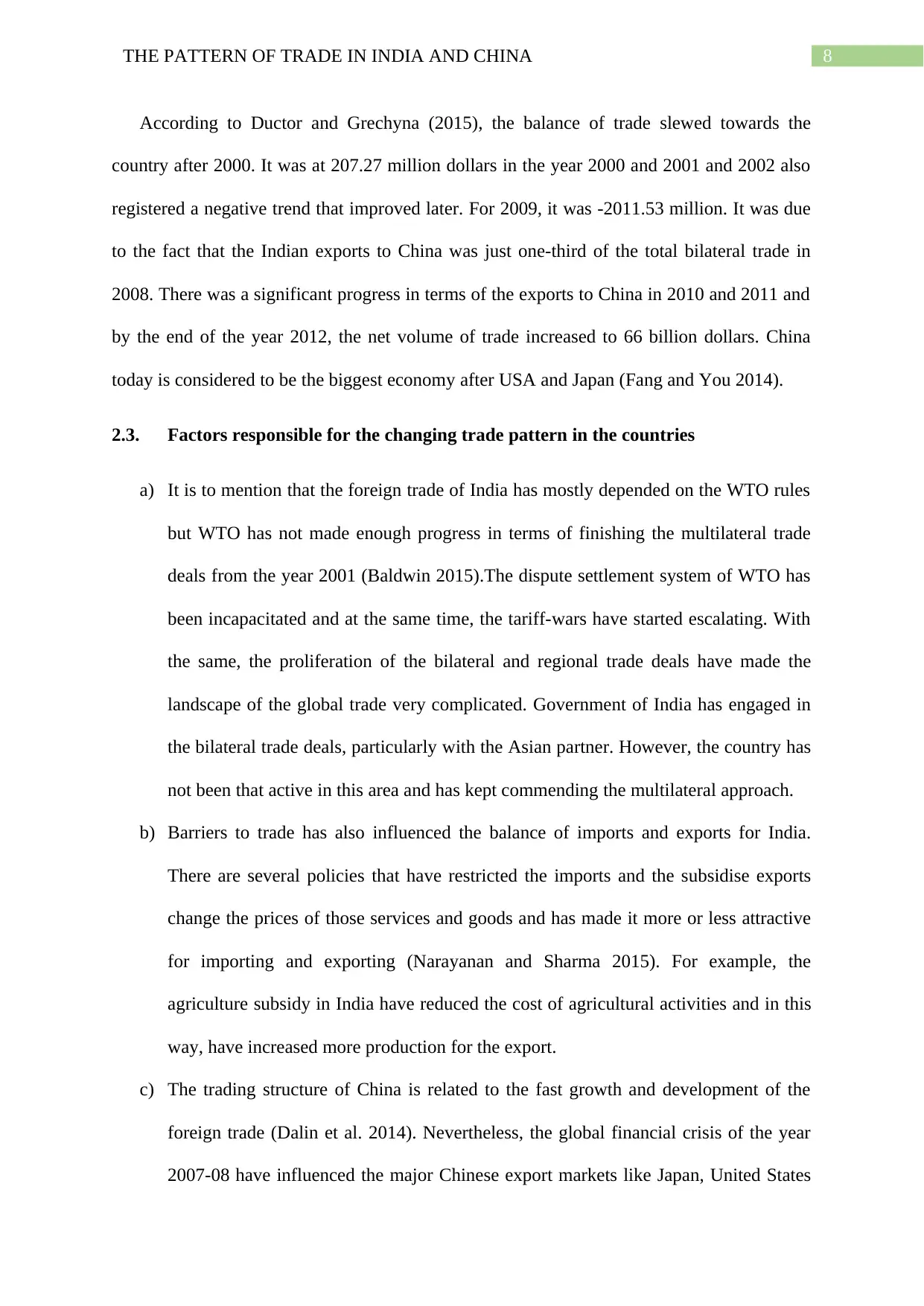
8THE PATTERN OF TRADE IN INDIA AND CHINA
According to Ductor and Grechyna (2015), the balance of trade slewed towards the
country after 2000. It was at 207.27 million dollars in the year 2000 and 2001 and 2002 also
registered a negative trend that improved later. For 2009, it was -2011.53 million. It was due
to the fact that the Indian exports to China was just one-third of the total bilateral trade in
2008. There was a significant progress in terms of the exports to China in 2010 and 2011 and
by the end of the year 2012, the net volume of trade increased to 66 billion dollars. China
today is considered to be the biggest economy after USA and Japan (Fang and You 2014).
2.3. Factors responsible for the changing trade pattern in the countries
a) It is to mention that the foreign trade of India has mostly depended on the WTO rules
but WTO has not made enough progress in terms of finishing the multilateral trade
deals from the year 2001 (Baldwin 2015).The dispute settlement system of WTO has
been incapacitated and at the same time, the tariff-wars have started escalating. With
the same, the proliferation of the bilateral and regional trade deals have made the
landscape of the global trade very complicated. Government of India has engaged in
the bilateral trade deals, particularly with the Asian partner. However, the country has
not been that active in this area and has kept commending the multilateral approach.
b) Barriers to trade has also influenced the balance of imports and exports for India.
There are several policies that have restricted the imports and the subsidise exports
change the prices of those services and goods and has made it more or less attractive
for importing and exporting (Narayanan and Sharma 2015). For example, the
agriculture subsidy in India have reduced the cost of agricultural activities and in this
way, have increased more production for the export.
c) The trading structure of China is related to the fast growth and development of the
foreign trade (Dalin et al. 2014). Nevertheless, the global financial crisis of the year
2007-08 have influenced the major Chinese export markets like Japan, United States
According to Ductor and Grechyna (2015), the balance of trade slewed towards the
country after 2000. It was at 207.27 million dollars in the year 2000 and 2001 and 2002 also
registered a negative trend that improved later. For 2009, it was -2011.53 million. It was due
to the fact that the Indian exports to China was just one-third of the total bilateral trade in
2008. There was a significant progress in terms of the exports to China in 2010 and 2011 and
by the end of the year 2012, the net volume of trade increased to 66 billion dollars. China
today is considered to be the biggest economy after USA and Japan (Fang and You 2014).
2.3. Factors responsible for the changing trade pattern in the countries
a) It is to mention that the foreign trade of India has mostly depended on the WTO rules
but WTO has not made enough progress in terms of finishing the multilateral trade
deals from the year 2001 (Baldwin 2015).The dispute settlement system of WTO has
been incapacitated and at the same time, the tariff-wars have started escalating. With
the same, the proliferation of the bilateral and regional trade deals have made the
landscape of the global trade very complicated. Government of India has engaged in
the bilateral trade deals, particularly with the Asian partner. However, the country has
not been that active in this area and has kept commending the multilateral approach.
b) Barriers to trade has also influenced the balance of imports and exports for India.
There are several policies that have restricted the imports and the subsidise exports
change the prices of those services and goods and has made it more or less attractive
for importing and exporting (Narayanan and Sharma 2015). For example, the
agriculture subsidy in India have reduced the cost of agricultural activities and in this
way, have increased more production for the export.
c) The trading structure of China is related to the fast growth and development of the
foreign trade (Dalin et al. 2014). Nevertheless, the global financial crisis of the year
2007-08 have influenced the major Chinese export markets like Japan, United States
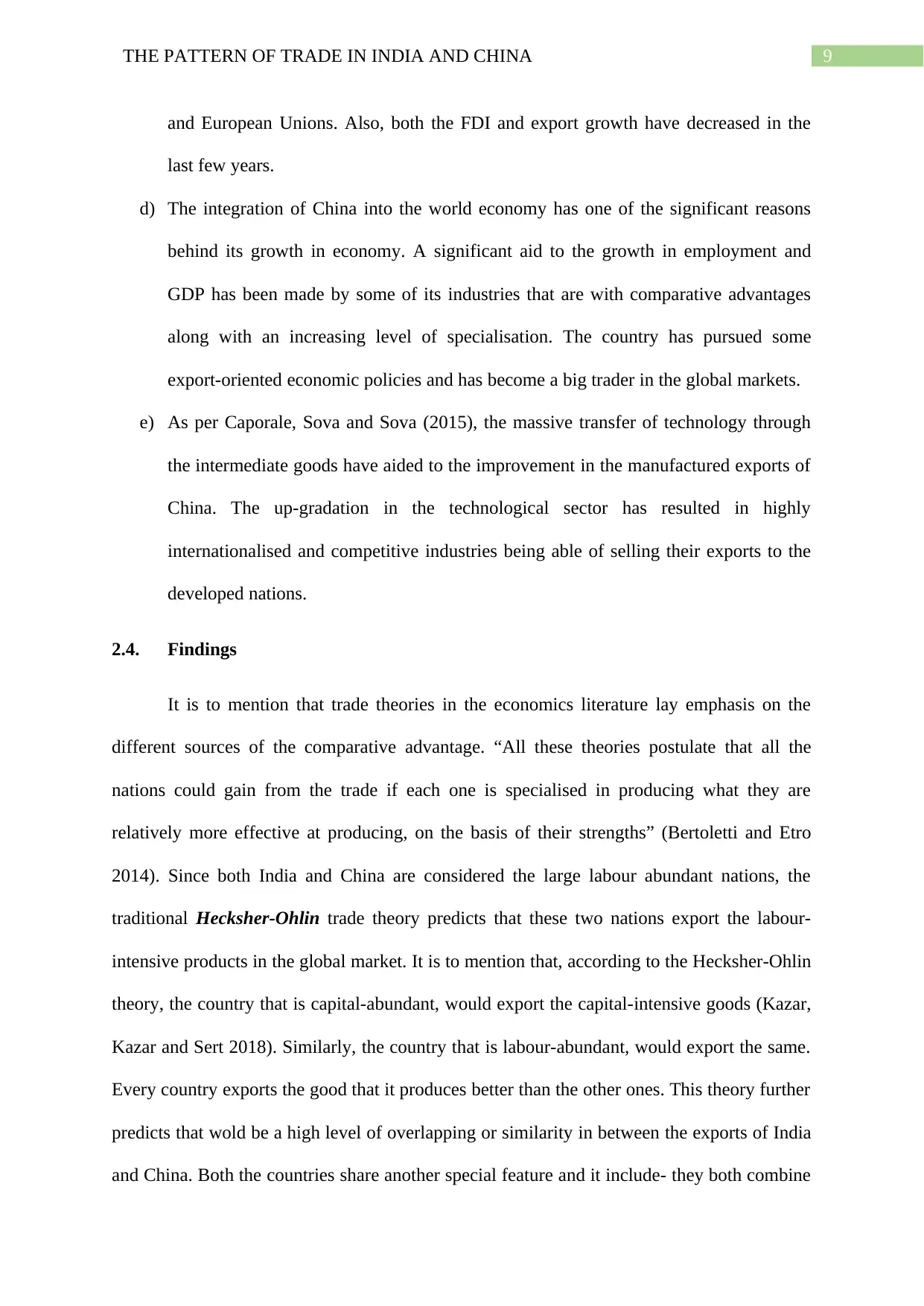
9THE PATTERN OF TRADE IN INDIA AND CHINA
and European Unions. Also, both the FDI and export growth have decreased in the
last few years.
d) The integration of China into the world economy has one of the significant reasons
behind its growth in economy. A significant aid to the growth in employment and
GDP has been made by some of its industries that are with comparative advantages
along with an increasing level of specialisation. The country has pursued some
export-oriented economic policies and has become a big trader in the global markets.
e) As per Caporale, Sova and Sova (2015), the massive transfer of technology through
the intermediate goods have aided to the improvement in the manufactured exports of
China. The up-gradation in the technological sector has resulted in highly
internationalised and competitive industries being able of selling their exports to the
developed nations.
2.4. Findings
It is to mention that trade theories in the economics literature lay emphasis on the
different sources of the comparative advantage. “All these theories postulate that all the
nations could gain from the trade if each one is specialised in producing what they are
relatively more effective at producing, on the basis of their strengths” (Bertoletti and Etro
2014). Since both India and China are considered the large labour abundant nations, the
traditional Hecksher-Ohlin trade theory predicts that these two nations export the labour-
intensive products in the global market. It is to mention that, according to the Hecksher-Ohlin
theory, the country that is capital-abundant, would export the capital-intensive goods (Kazar,
Kazar and Sert 2018). Similarly, the country that is labour-abundant, would export the same.
Every country exports the good that it produces better than the other ones. This theory further
predicts that wold be a high level of overlapping or similarity in between the exports of India
and China. Both the countries share another special feature and it include- they both combine
and European Unions. Also, both the FDI and export growth have decreased in the
last few years.
d) The integration of China into the world economy has one of the significant reasons
behind its growth in economy. A significant aid to the growth in employment and
GDP has been made by some of its industries that are with comparative advantages
along with an increasing level of specialisation. The country has pursued some
export-oriented economic policies and has become a big trader in the global markets.
e) As per Caporale, Sova and Sova (2015), the massive transfer of technology through
the intermediate goods have aided to the improvement in the manufactured exports of
China. The up-gradation in the technological sector has resulted in highly
internationalised and competitive industries being able of selling their exports to the
developed nations.
2.4. Findings
It is to mention that trade theories in the economics literature lay emphasis on the
different sources of the comparative advantage. “All these theories postulate that all the
nations could gain from the trade if each one is specialised in producing what they are
relatively more effective at producing, on the basis of their strengths” (Bertoletti and Etro
2014). Since both India and China are considered the large labour abundant nations, the
traditional Hecksher-Ohlin trade theory predicts that these two nations export the labour-
intensive products in the global market. It is to mention that, according to the Hecksher-Ohlin
theory, the country that is capital-abundant, would export the capital-intensive goods (Kazar,
Kazar and Sert 2018). Similarly, the country that is labour-abundant, would export the same.
Every country exports the good that it produces better than the other ones. This theory further
predicts that wold be a high level of overlapping or similarity in between the exports of India
and China. Both the countries share another special feature and it include- they both combine
Secure Best Marks with AI Grader
Need help grading? Try our AI Grader for instant feedback on your assignments.
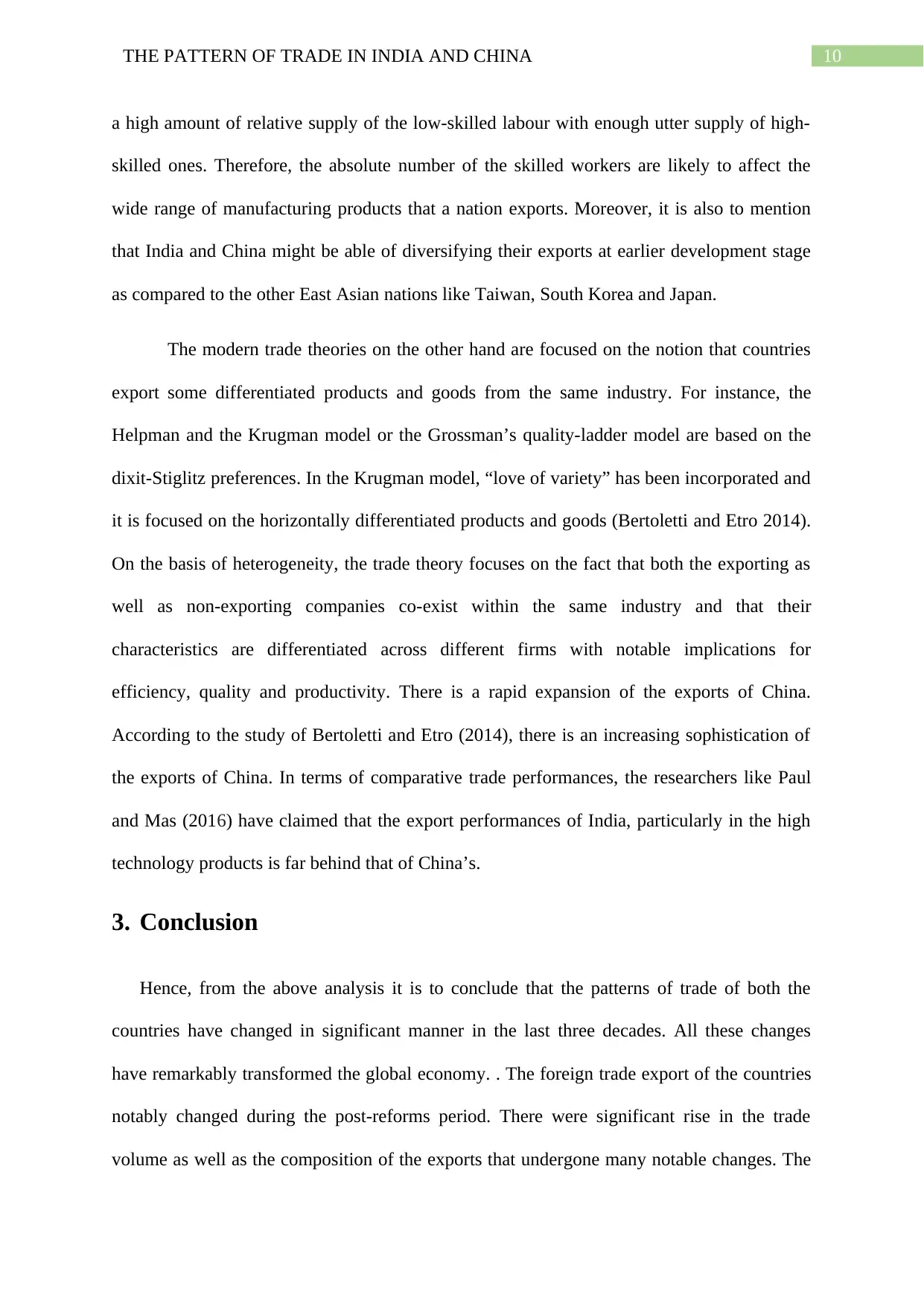
10THE PATTERN OF TRADE IN INDIA AND CHINA
a high amount of relative supply of the low-skilled labour with enough utter supply of high-
skilled ones. Therefore, the absolute number of the skilled workers are likely to affect the
wide range of manufacturing products that a nation exports. Moreover, it is also to mention
that India and China might be able of diversifying their exports at earlier development stage
as compared to the other East Asian nations like Taiwan, South Korea and Japan.
The modern trade theories on the other hand are focused on the notion that countries
export some differentiated products and goods from the same industry. For instance, the
Helpman and the Krugman model or the Grossman’s quality-ladder model are based on the
dixit-Stiglitz preferences. In the Krugman model, “love of variety” has been incorporated and
it is focused on the horizontally differentiated products and goods (Bertoletti and Etro 2014).
On the basis of heterogeneity, the trade theory focuses on the fact that both the exporting as
well as non-exporting companies co-exist within the same industry and that their
characteristics are differentiated across different firms with notable implications for
efficiency, quality and productivity. There is a rapid expansion of the exports of China.
According to the study of Bertoletti and Etro (2014), there is an increasing sophistication of
the exports of China. In terms of comparative trade performances, the researchers like Paul
and Mas (2016) have claimed that the export performances of India, particularly in the high
technology products is far behind that of China’s.
3. Conclusion
Hence, from the above analysis it is to conclude that the patterns of trade of both the
countries have changed in significant manner in the last three decades. All these changes
have remarkably transformed the global economy. . The foreign trade export of the countries
notably changed during the post-reforms period. There were significant rise in the trade
volume as well as the composition of the exports that undergone many notable changes. The
a high amount of relative supply of the low-skilled labour with enough utter supply of high-
skilled ones. Therefore, the absolute number of the skilled workers are likely to affect the
wide range of manufacturing products that a nation exports. Moreover, it is also to mention
that India and China might be able of diversifying their exports at earlier development stage
as compared to the other East Asian nations like Taiwan, South Korea and Japan.
The modern trade theories on the other hand are focused on the notion that countries
export some differentiated products and goods from the same industry. For instance, the
Helpman and the Krugman model or the Grossman’s quality-ladder model are based on the
dixit-Stiglitz preferences. In the Krugman model, “love of variety” has been incorporated and
it is focused on the horizontally differentiated products and goods (Bertoletti and Etro 2014).
On the basis of heterogeneity, the trade theory focuses on the fact that both the exporting as
well as non-exporting companies co-exist within the same industry and that their
characteristics are differentiated across different firms with notable implications for
efficiency, quality and productivity. There is a rapid expansion of the exports of China.
According to the study of Bertoletti and Etro (2014), there is an increasing sophistication of
the exports of China. In terms of comparative trade performances, the researchers like Paul
and Mas (2016) have claimed that the export performances of India, particularly in the high
technology products is far behind that of China’s.
3. Conclusion
Hence, from the above analysis it is to conclude that the patterns of trade of both the
countries have changed in significant manner in the last three decades. All these changes
have remarkably transformed the global economy. . The foreign trade export of the countries
notably changed during the post-reforms period. There were significant rise in the trade
volume as well as the composition of the exports that undergone many notable changes. The
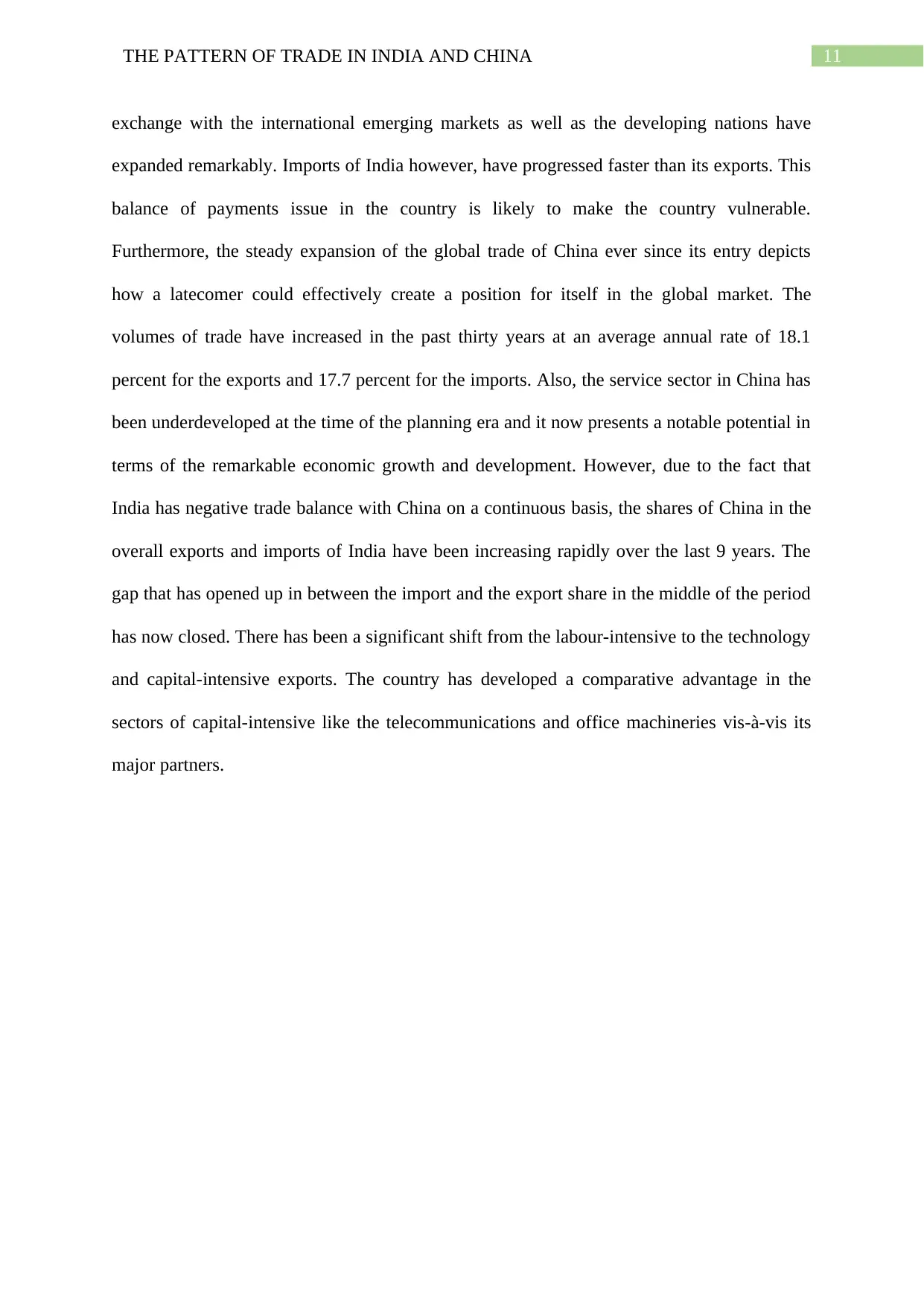
11THE PATTERN OF TRADE IN INDIA AND CHINA
exchange with the international emerging markets as well as the developing nations have
expanded remarkably. Imports of India however, have progressed faster than its exports. This
balance of payments issue in the country is likely to make the country vulnerable.
Furthermore, the steady expansion of the global trade of China ever since its entry depicts
how a latecomer could effectively create a position for itself in the global market. The
volumes of trade have increased in the past thirty years at an average annual rate of 18.1
percent for the exports and 17.7 percent for the imports. Also, the service sector in China has
been underdeveloped at the time of the planning era and it now presents a notable potential in
terms of the remarkable economic growth and development. However, due to the fact that
India has negative trade balance with China on a continuous basis, the shares of China in the
overall exports and imports of India have been increasing rapidly over the last 9 years. The
gap that has opened up in between the import and the export share in the middle of the period
has now closed. There has been a significant shift from the labour-intensive to the technology
and capital-intensive exports. The country has developed a comparative advantage in the
sectors of capital-intensive like the telecommunications and office machineries vis-à-vis its
major partners.
exchange with the international emerging markets as well as the developing nations have
expanded remarkably. Imports of India however, have progressed faster than its exports. This
balance of payments issue in the country is likely to make the country vulnerable.
Furthermore, the steady expansion of the global trade of China ever since its entry depicts
how a latecomer could effectively create a position for itself in the global market. The
volumes of trade have increased in the past thirty years at an average annual rate of 18.1
percent for the exports and 17.7 percent for the imports. Also, the service sector in China has
been underdeveloped at the time of the planning era and it now presents a notable potential in
terms of the remarkable economic growth and development. However, due to the fact that
India has negative trade balance with China on a continuous basis, the shares of China in the
overall exports and imports of India have been increasing rapidly over the last 9 years. The
gap that has opened up in between the import and the export share in the middle of the period
has now closed. There has been a significant shift from the labour-intensive to the technology
and capital-intensive exports. The country has developed a comparative advantage in the
sectors of capital-intensive like the telecommunications and office machineries vis-à-vis its
major partners.
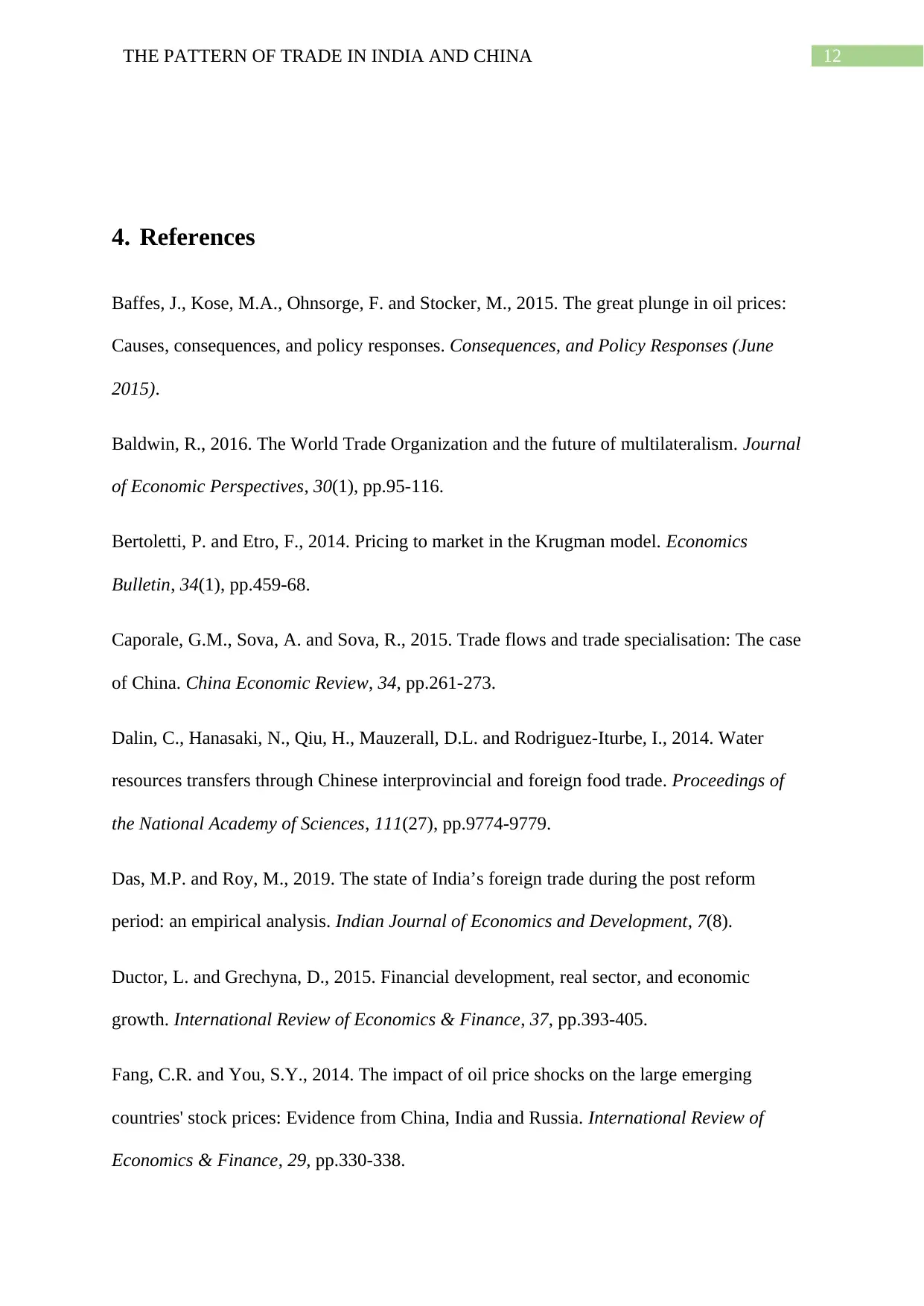
12THE PATTERN OF TRADE IN INDIA AND CHINA
4. References
Baffes, J., Kose, M.A., Ohnsorge, F. and Stocker, M., 2015. The great plunge in oil prices:
Causes, consequences, and policy responses. Consequences, and Policy Responses (June
2015).
Baldwin, R., 2016. The World Trade Organization and the future of multilateralism. Journal
of Economic Perspectives, 30(1), pp.95-116.
Bertoletti, P. and Etro, F., 2014. Pricing to market in the Krugman model. Economics
Bulletin, 34(1), pp.459-68.
Caporale, G.M., Sova, A. and Sova, R., 2015. Trade flows and trade specialisation: The case
of China. China Economic Review, 34, pp.261-273.
Dalin, C., Hanasaki, N., Qiu, H., Mauzerall, D.L. and Rodriguez-Iturbe, I., 2014. Water
resources transfers through Chinese interprovincial and foreign food trade. Proceedings of
the National Academy of Sciences, 111(27), pp.9774-9779.
Das, M.P. and Roy, M., 2019. The state of India’s foreign trade during the post reform
period: an empirical analysis. Indian Journal of Economics and Development, 7(8).
Ductor, L. and Grechyna, D., 2015. Financial development, real sector, and economic
growth. International Review of Economics & Finance, 37, pp.393-405.
Fang, C.R. and You, S.Y., 2014. The impact of oil price shocks on the large emerging
countries' stock prices: Evidence from China, India and Russia. International Review of
Economics & Finance, 29, pp.330-338.
4. References
Baffes, J., Kose, M.A., Ohnsorge, F. and Stocker, M., 2015. The great plunge in oil prices:
Causes, consequences, and policy responses. Consequences, and Policy Responses (June
2015).
Baldwin, R., 2016. The World Trade Organization and the future of multilateralism. Journal
of Economic Perspectives, 30(1), pp.95-116.
Bertoletti, P. and Etro, F., 2014. Pricing to market in the Krugman model. Economics
Bulletin, 34(1), pp.459-68.
Caporale, G.M., Sova, A. and Sova, R., 2015. Trade flows and trade specialisation: The case
of China. China Economic Review, 34, pp.261-273.
Dalin, C., Hanasaki, N., Qiu, H., Mauzerall, D.L. and Rodriguez-Iturbe, I., 2014. Water
resources transfers through Chinese interprovincial and foreign food trade. Proceedings of
the National Academy of Sciences, 111(27), pp.9774-9779.
Das, M.P. and Roy, M., 2019. The state of India’s foreign trade during the post reform
period: an empirical analysis. Indian Journal of Economics and Development, 7(8).
Ductor, L. and Grechyna, D., 2015. Financial development, real sector, and economic
growth. International Review of Economics & Finance, 37, pp.393-405.
Fang, C.R. and You, S.Y., 2014. The impact of oil price shocks on the large emerging
countries' stock prices: Evidence from China, India and Russia. International Review of
Economics & Finance, 29, pp.330-338.
Paraphrase This Document
Need a fresh take? Get an instant paraphrase of this document with our AI Paraphraser
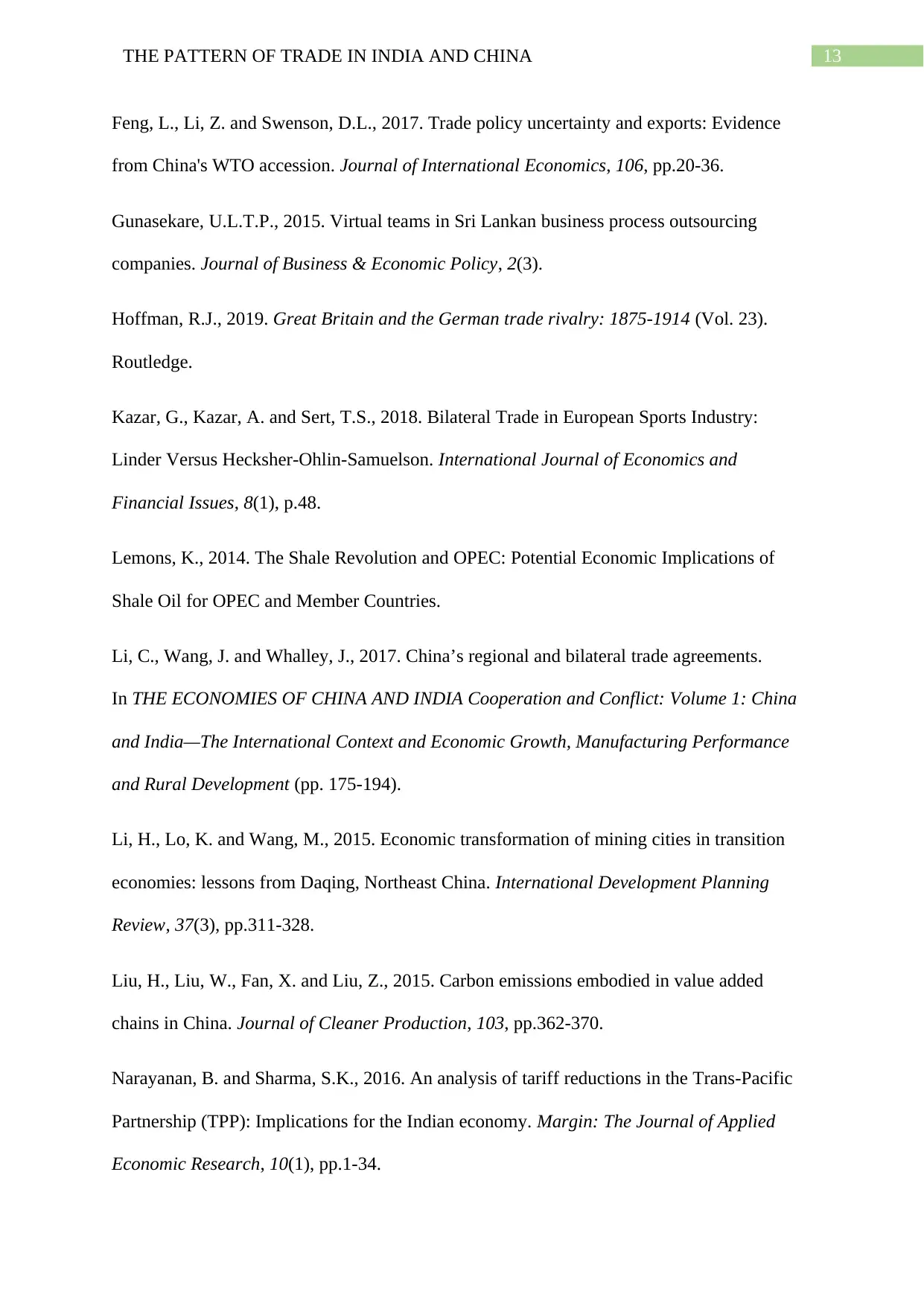
13THE PATTERN OF TRADE IN INDIA AND CHINA
Feng, L., Li, Z. and Swenson, D.L., 2017. Trade policy uncertainty and exports: Evidence
from China's WTO accession. Journal of International Economics, 106, pp.20-36.
Gunasekare, U.L.T.P., 2015. Virtual teams in Sri Lankan business process outsourcing
companies. Journal of Business & Economic Policy, 2(3).
Hoffman, R.J., 2019. Great Britain and the German trade rivalry: 1875-1914 (Vol. 23).
Routledge.
Kazar, G., Kazar, A. and Sert, T.S., 2018. Bilateral Trade in European Sports Industry:
Linder Versus Hecksher-Ohlin-Samuelson. International Journal of Economics and
Financial Issues, 8(1), p.48.
Lemons, K., 2014. The Shale Revolution and OPEC: Potential Economic Implications of
Shale Oil for OPEC and Member Countries.
Li, C., Wang, J. and Whalley, J., 2017. China’s regional and bilateral trade agreements.
In THE ECONOMIES OF CHINA AND INDIA Cooperation and Conflict: Volume 1: China
and India—The International Context and Economic Growth, Manufacturing Performance
and Rural Development (pp. 175-194).
Li, H., Lo, K. and Wang, M., 2015. Economic transformation of mining cities in transition
economies: lessons from Daqing, Northeast China. International Development Planning
Review, 37(3), pp.311-328.
Liu, H., Liu, W., Fan, X. and Liu, Z., 2015. Carbon emissions embodied in value added
chains in China. Journal of Cleaner Production, 103, pp.362-370.
Narayanan, B. and Sharma, S.K., 2016. An analysis of tariff reductions in the Trans-Pacific
Partnership (TPP): Implications for the Indian economy. Margin: The Journal of Applied
Economic Research, 10(1), pp.1-34.
Feng, L., Li, Z. and Swenson, D.L., 2017. Trade policy uncertainty and exports: Evidence
from China's WTO accession. Journal of International Economics, 106, pp.20-36.
Gunasekare, U.L.T.P., 2015. Virtual teams in Sri Lankan business process outsourcing
companies. Journal of Business & Economic Policy, 2(3).
Hoffman, R.J., 2019. Great Britain and the German trade rivalry: 1875-1914 (Vol. 23).
Routledge.
Kazar, G., Kazar, A. and Sert, T.S., 2018. Bilateral Trade in European Sports Industry:
Linder Versus Hecksher-Ohlin-Samuelson. International Journal of Economics and
Financial Issues, 8(1), p.48.
Lemons, K., 2014. The Shale Revolution and OPEC: Potential Economic Implications of
Shale Oil for OPEC and Member Countries.
Li, C., Wang, J. and Whalley, J., 2017. China’s regional and bilateral trade agreements.
In THE ECONOMIES OF CHINA AND INDIA Cooperation and Conflict: Volume 1: China
and India—The International Context and Economic Growth, Manufacturing Performance
and Rural Development (pp. 175-194).
Li, H., Lo, K. and Wang, M., 2015. Economic transformation of mining cities in transition
economies: lessons from Daqing, Northeast China. International Development Planning
Review, 37(3), pp.311-328.
Liu, H., Liu, W., Fan, X. and Liu, Z., 2015. Carbon emissions embodied in value added
chains in China. Journal of Cleaner Production, 103, pp.362-370.
Narayanan, B. and Sharma, S.K., 2016. An analysis of tariff reductions in the Trans-Pacific
Partnership (TPP): Implications for the Indian economy. Margin: The Journal of Applied
Economic Research, 10(1), pp.1-34.
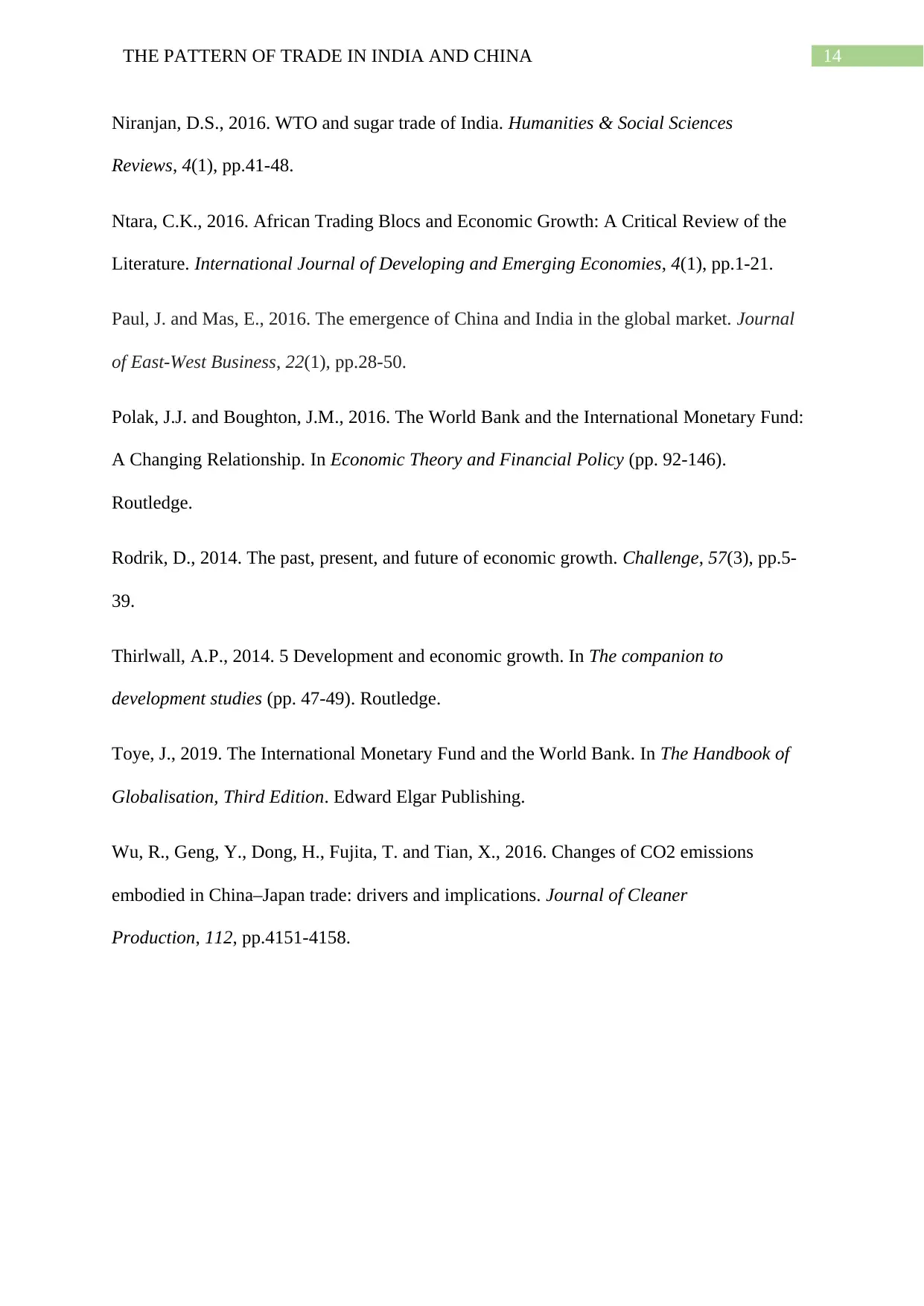
14THE PATTERN OF TRADE IN INDIA AND CHINA
Niranjan, D.S., 2016. WTO and sugar trade of India. Humanities & Social Sciences
Reviews, 4(1), pp.41-48.
Ntara, C.K., 2016. African Trading Blocs and Economic Growth: A Critical Review of the
Literature. International Journal of Developing and Emerging Economies, 4(1), pp.1-21.
Paul, J. and Mas, E., 2016. The emergence of China and India in the global market. Journal
of East-West Business, 22(1), pp.28-50.
Polak, J.J. and Boughton, J.M., 2016. The World Bank and the International Monetary Fund:
A Changing Relationship. In Economic Theory and Financial Policy (pp. 92-146).
Routledge.
Rodrik, D., 2014. The past, present, and future of economic growth. Challenge, 57(3), pp.5-
39.
Thirlwall, A.P., 2014. 5 Development and economic growth. In The companion to
development studies (pp. 47-49). Routledge.
Toye, J., 2019. The International Monetary Fund and the World Bank. In The Handbook of
Globalisation, Third Edition. Edward Elgar Publishing.
Wu, R., Geng, Y., Dong, H., Fujita, T. and Tian, X., 2016. Changes of CO2 emissions
embodied in China–Japan trade: drivers and implications. Journal of Cleaner
Production, 112, pp.4151-4158.
Niranjan, D.S., 2016. WTO and sugar trade of India. Humanities & Social Sciences
Reviews, 4(1), pp.41-48.
Ntara, C.K., 2016. African Trading Blocs and Economic Growth: A Critical Review of the
Literature. International Journal of Developing and Emerging Economies, 4(1), pp.1-21.
Paul, J. and Mas, E., 2016. The emergence of China and India in the global market. Journal
of East-West Business, 22(1), pp.28-50.
Polak, J.J. and Boughton, J.M., 2016. The World Bank and the International Monetary Fund:
A Changing Relationship. In Economic Theory and Financial Policy (pp. 92-146).
Routledge.
Rodrik, D., 2014. The past, present, and future of economic growth. Challenge, 57(3), pp.5-
39.
Thirlwall, A.P., 2014. 5 Development and economic growth. In The companion to
development studies (pp. 47-49). Routledge.
Toye, J., 2019. The International Monetary Fund and the World Bank. In The Handbook of
Globalisation, Third Edition. Edward Elgar Publishing.
Wu, R., Geng, Y., Dong, H., Fujita, T. and Tian, X., 2016. Changes of CO2 emissions
embodied in China–Japan trade: drivers and implications. Journal of Cleaner
Production, 112, pp.4151-4158.
1 out of 15
Related Documents
Your All-in-One AI-Powered Toolkit for Academic Success.
+13062052269
info@desklib.com
Available 24*7 on WhatsApp / Email
![[object Object]](/_next/static/media/star-bottom.7253800d.svg)
Unlock your academic potential
© 2024 | Zucol Services PVT LTD | All rights reserved.




